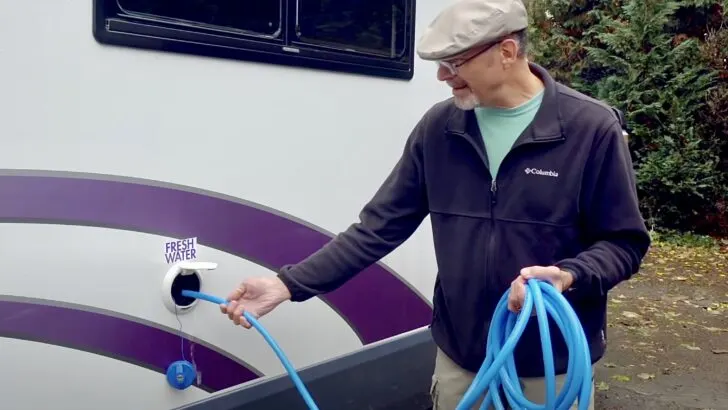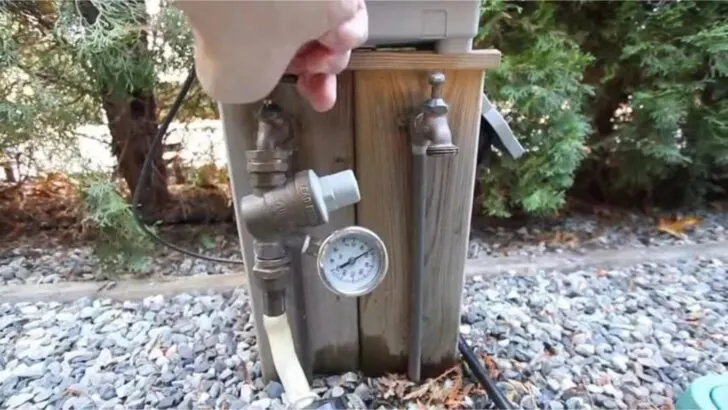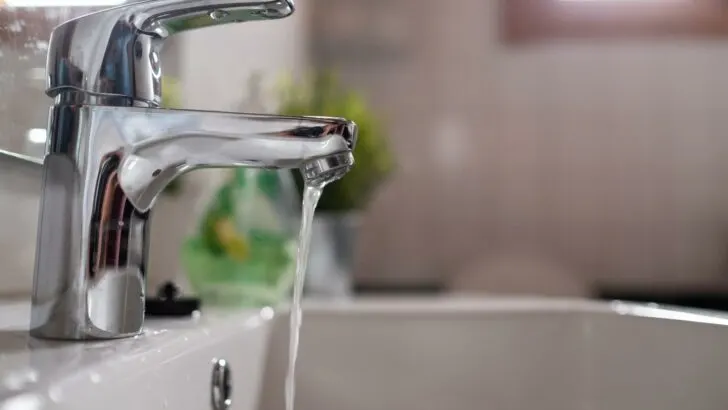Many rigs have a difference between their RV fresh water connection vs city water connection. The problem is that the difference can be subtle, and not all RVs are set up the same way, so it can be a bit confusing.
After 20 years on the road, we tend to take some things for granted because we’ve been doing them for so long. But newer RVers often have a learning curve to master, and some things aren’t obvious. This topic tends to be one of them.
In this post, we’ll discuss the differences between RV fresh water and city water connections, and why it’s helpful to understand what they do.
What Is a Fresh Water Connection?
An RV fresh water connection is a way to add potable (safe to drink) water to fill the RV’s fresh water tank. Most freshwater connections are “gravity fill,” meaning there’s an opening in the side of the RV for filling the tank with fresh water. So this might not technically be a “connection” since the hose isn’t screwed into it. But it is the route that fresh water follows to enter the fresh tank.
This is usually done by aiming the end of a drinking water-safe hose (usually white or blue) into the opening to direct water into the fresh water holding tank to fill it up. Water can also be added into a gravity-fill opening from a portable container or water bladder.

Peter is shown here filling the fresh water tank through the gravity fill on a motorhome in England. In other countries we’ve RVed in throughout Europe, Australia, and New Zealand, there is only the option for filling the tank this way. There’s no city water connection at all, meaning it’s not possible to pressurize the RV’s plumbing system using a tap/spigot at a campground. So using the water pump is the only way to get running water onboard.
In some cases, an RV’s fresh water connection can have a standard garden-hose-style screw-on connection. Since this requires pressurized water to fill the freshwater tank, pouring water in from a portable container isn’t possible through this type of connection.
If your fresh water connection is threaded, you’ll attach an RV water hose to fill the onboard tank with potable water from a pressurized plumbing system. (By the way… fans of Jeopardy may recall hearing Alex Trebek pronounce the occasional category “Potent Potables” properly — it’s “POE-table” water, not “POT-able” water.)
Once you have that safe-to-drink water in the tank, you’ll want to keep it safe – sanitize your fresh water tank periodically… or install a UV-LED water purification system.
- Drinking Water Safe: Made of NSF certified hose; won't impart a strong plastic taste to the water
- Heavy-Duty Hose: Is 20% thicker than our standard hoses and features a no-kink design
What Is a City Water Connection?
A city water connection is where you connect the RV’s fresh water plumbing to a tap/spigot — usually at a campsite — in order to have that city water pressurize the water lines in the entire RV. That supplies water directly to your rig’s faucets, shower, and toilet any time you’re hooked up to a city water connection. No water pumped is needed to keep water flowing.

A water pressure regulator and drinking water-safe hose connected to a city water source at a campground.
Many RVers (wisely) choose to add an inline water filter to this connection if their RV isn’t already equipped with a built-in whole-house filter.
- ADVANCED 6-STEP FILTRATION TECHNOLOGY: Experience the extraordinary power of Hex-Flow Technology & its remarkable 6-step filtration process. Every...
- CERTIFIED LEAD-FREE: These camping water filters are independently tested & listed to standards NSF/ANSI 42 & NSF/ANSI 53. They are CSA lead-free...
An important note:
When connected to any pressurized water source, such as a city water connection at a campground, using a water pressure regulator is essential. The regulator’s job is to ensure that the pressure coming into the motorhome, travel trailer, or 5th wheel isn’t too high for the RV’s plumbing system.
Many RV manufacturers recommend that the water pressure supplied to an RV not exceed 60 psi, with a comfortable recommended pressure of around 40-50 psi. This requires a water pressure regulator.
Without a regulator, excessive pressure could cause serious damage to your RV water system… and even your entire rig. The potential for excessively high pressure and the damage it can cause (burst pipes and flooding) simply isn’t worth the risk. We never (ever) connect to city water without a quality water pressure regulator.
For more information, see our post “Does My RV Need a Water Pressure Regulator?”
- WATER REGULATOR: Versatile water regulator is compatible with standard campers, RV's, trailers, and more
- IDEAL PRESSURE: Regulates water pressure to your preference with pressure gauge
Are Fresh Water Connections and City Water Connections Separate?
In many (even most) RVs, the fresh water and city water connections are separate. So, there are two connections. One is the port for filling the freshwater tank. The other connects the RV’s plumbing system directly to the pressurized city water supply (thereby pressurizing the plumbing throughout the RV).
However, in some RVs (ours, for example), there’s only a single connection for water (sometimes a permanently attached hose, often on a reel). So our rig has only one way to attach to a water supply – a single threaded connection that pressurizes our plumbing and fills our fresh tank.
The hose gets attached to the city water supply tap/spigot at the campground. A diverter valve controls the “destination” of the water — either to fill the fresh tank or to pressurize the plumbing system.
It’s important to know which setup you have in your RV. If you don’t know to turn the valve in the proper direction, you won’t be able to direct water to the desired location (either to the rig’s plumbing system or to fill the freshwater tank).
Whether your RV has one connection with a valve, or two separate connections, it’s important to know how and where to fill your fresh water tank, and how to connect a pressurized city water source to your RV so that you can use the city water connection to supply the water to your RV’s faucets, shower(s), and toilet.
True story from when we were newbies: Not long after we started RVing, we were getting ready to leave a full hook-up campground one morning. We discovered that our fresh water tank was completely empty, despite our having topped it up upon arrival.
We realized that we’d accidentally turned on the water pump the night before, even though we were fully hooked up (so, of course, we didn’t need the pump). What happened is that the check valve/backflow preventer in the water system (the one that prevents water from being pumped backward out of the RV’s water hose) had failed.
Apparently, the campground had very low water pressure — lower than the pressure from our water pump. That allowed the pump to slowly but surely pump the entire contents of our 105-gallon fresh water tank back into the campground’s water system overnight.
We never heard the pump running while we were sleeping, and luckily, the pump didn’t burn out when the tank was empty. I guess it’s a good thing we sanitize our tank so that we didn’t contaminate the park’s water supply!
This is a great example of why our old motto from when we first started making YouTube videos was: “We learn things the hard way so that you don’t have to!” 🤣
We replaced that original plastic backflow preventer with a high-quality brass one, and we’ve never topped up a campground’s water supply since!
- One Direction Water Flow: Allows water to flow only in one direction— towards your RV’s hot water heater; it does not allow water to pass another...
- Stops Backflow: Helps stop backflow from your water heater and into your freshwater system
Low Water Pressure When Connected?

If you find yourself with low water pressure in your RV, there are several steps you can take to troubleshoot and fix the issue.
If you’ve connected your rig to a city water source at a campground or anywhere else and you’ve found yourself with low water pressure, we’ve got some great tips for you. Check out our post on low water pressure in RVs for lots of great information.
Free RVing Tips, Tricks, Reviews, Giveaways & More
Subscribe to our daily newsletter! We’ve been full-time RVers for 20 years (!) and share everything we’ve learned about RVing in our daily blog posts. Join our online community to receive a wealth of great RVing knowledge delivered right to your inbox.
Whether this is your first time on the road or you’re a seasoned full-timer, you’ll love the wide range of RVing topics we cover. Don’t miss a single article or any of our famous RV gear Giveaways — Subscribe today!






Alan Pickering
Saturday 12th of August 2023
Good article. If you want to be absolutely sure of having 100% pure drinking water, filtered down to one thousands of a micron, which results in no need for chemical treatments or UV equipment, check out the recently developed system by the water scientists from The Thirsty Nomad labs. I use it in our off-road caravan in outback Australia with full confidence. I mention this to get the word out there about this purification system, which IMHO is simple, effective and superior to other methods you often see being pushed by slick marketers. And no, I am not sponsored by The Thirsty Nomad, or ever received any discount or benefits from them, being merely a retail customer of theirs. The old adage of "build a better mouse trap and the world will beat a path to your door", no longer applies in today's world of PR and spin and I would hate to see them disappear from the market place due to such big business practices.
Smitty
Friday 11th of August 2023
Like G Nelson, we always have a spray bottle with a light mix of bleach and water to spay the water spicket and handle. While our coach does have a built in residential WATTS Pressure Regulator and whole house filter. We use a at the bit Pressure Regulator and the Camco Blue Hose Bib Filter. The bib regulator protects the hose, and if needed, or On the Go Double Water Softener. And that Softener, and the whole house 10" filter, are helped by screening out the larger sediments via the Camco Blue Hose Bib Filter too:)! Water safety is not an accident, it's a practice. Is a motto a share with friends who are just starting RV'ing:)! Nice piece, as usual - THANK YOU!
G Nelson
Friday 11th of August 2023
I always like to remind anyone connecting or using a water source that is low to the ground to be sure to sanitize the whole source. This includes the handle and connections areas. Most of these are at the perfect height for a dog to lift a leg on. 🤮
Bruce Hislop
Saturday 12th of August 2023
@G Nelson, That reminds me of when we always got wet mail, even after a week of no rains! Then I saw a dog relieving himself... our mailbox was on the bottom row of a multi-box mail drop in a rural area. Turned out to be a regular stopping spot for the local dogs.
So I went to post office, told them of my issue and asked for an unused box near the top. Always had dry mail after that!!
Bruce Hislop
Friday 11th of August 2023
We only use our fresh water tank, never the city hookup. The reason for this is if you hear your fresh water pump randomly running when no water is being used, you likely have a leak in your water system. This is your clue to investigate and repair the leak before it causes expensive damage. On city water you would never know you have a leak until its large enough to come out onto the floor. A slow leak will be undetected for a long time while a large leak could flood your RV with hundreds of gallons if it happens while you are away from your RV. Using the fresh water tank only the most water in your RV will be what was in the tank at the time of the large leak. Also we shut OFF our pump when we leave the coach so we will likely be there if a pipe burst. Another benefit is since our black tank is slightly larger than the fresh water tank, once the fresh water tank gets near empty the black water tank is near full. JWID